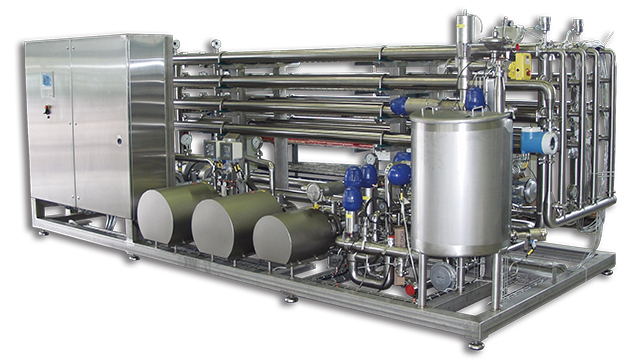Lowal De-alcoholizer
Dealcoholize all beer and fermented low-alcohol drink types in the same plant with the self-contained, fully-automated Alfa Laval Lowal dealcoholization system. Processing at low temperature preserves the natural flavour of the beer and prevents deterioration of the taste of the beer despite of the dealcoholization process. The result is a higher quality low alcohol or non-alcoholic beer and more energy efficient production.
Dealcoholization the practical and cost-effective way
- Dealcoholization process with low oxygen pick up
- Four standard sizes with up to 168 spiral membranes in three loops
- The same plant can handle all types of beer, including cloudy wheat beers and dark beers
- Capacities between 300 and 1,000 hl/day of dealcoholized beer with final alcohol concentration of <0.5% alcohol by volume
- All piping and equipment in contact with the product or cleaning liquids are of sanitary-level design
Brewing light or alcohol free beer
The system uses reverse osmosis spiral membranes in a high-hygiene set-up. It consists of four operations:
- Pre-concentration
- Diafiltration
- Alcohol adjustment
- Post-treatment
Each of these steps takes place at temperatures of 10-20ºC (50-68ºF) or less, resulting in a high-quality non-alcoholic beer whose flavour is unaffected by heating.
The membranes separate the feed beer into two streams. The permeate stream – consisting of water and alcohol – passes through the membranes. The retentate stream – consisting of concentrated proteins, colour and flavour compounds – doesn't, and can be led back to the beer tank.
The original beer from the beer tank is pumped to the dealcoholization unit. Two feed pumps then bring its pressure up to 35 bar. At this point, the beer is introduced into the first loop, where a pump circulates it over the membranes. The retentate from the first loop continues to the second loop and is recirculated over the membranes in loop two.
The retentate from loop two returns to the beer tank via a pressure release valve. The permeate from all loops is collected and either led to a drain or stored for water flush in the next CIP cycle.
The beer in the membrane module is made to flow parallel to the membrane surface, which keeps the membranes clean (cross-flow). Due to the static pressure of 30-35 bar, small molecules such as water and alcohol are pressed through, whereas the larger molecules, such as proteins, flavour-and colour compounds are stopped. These compounds remain in the retentate. These are the basic principles behind how to brew non-alcoholic beer.
Step 1: Pre-concentration
This step reduces the volume of the feed beer. After passing through the membrane modules, the feed beer is recirculated over the batch tank. The permeate is removed while the retentate goes back into the beer tank until the desired volume reduction has been achieved.
Step 2: Diafiltration process
This step involves washing out the alcohol using diafiltration. It's similar in principle to the pre-concentration step, but diafiltration water is now added. The diafiltration step reduces the alcohol content to the desired value for the final, low-alcohol beer.
Step 3: Alcohol adjustment
After diafiltration, the beer is adjusted further by adding deaerated water into the batch tank. This allows you to achieve the desired final alcohol and extract content for either a low-alcohol or non-alcoholic beer and to fine-tune the flavour. The amount of deaerated water added is normally the same as the amount of permeate in step one.
Step 4: Post-treatment
The dealcoholized beer can be given its special characteristics by adjusting CO2 levels, colour or flavour.
This dealcoholization solution is part of a broad range of membrane technology
Membrane filtration for removing alcohol from beer complements the range of other separation technologies offered by Alfa Laval. This ensures that we are always in a position to provide you with the ideal solution for your particular process. By using membrane filtration alone or in combination with our range of centrifuges, decanters or evaporators, you can adjust your brewing to fit the demands of your current and future customers.

